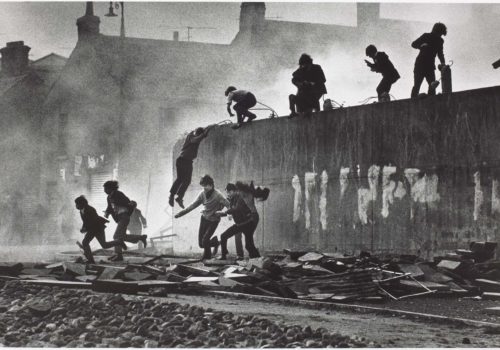Photojournalist Don McCullin risked his life covering civil wars on four continents from 1964 to 1985. As Harold Evans writes in the introduction to the catalogue produced by the National Gallery of Canada: “Don McCullin has guts. He can stop in the middle of a firefight to measure the exposure time.” To which the photographer responded: “Why risk getting killed for an underexposed picture?”
For McCullin, raw emotion is more important than the decisive moment. His intentions are clear: “No heroics are possible when you are photographing people who are starving,” McCullin wrote in his autobiography. “All I could do was try to give the people caught up in this terrible disaster as much dignity as possible.” In his role as a photographer, he tries to get the attention of the powers able to come to the victims’ aid.
Brought together for the first time in Canada, these 134 photographs taken from McCullin’s major series trace his journey over nearly half a century. The retrospective is unprecedented at the National Gallery of Canada, which had never before devoted a solo exhibition to a contemporary British photographer.
Reconciling within a single image the vision of the painter and photographer: that is McCullin’s art. His work represents in its own way a continuation of the political paintings of Otto Dix and Francisco de Goya, bearing witness to atrocities on the battlefield. McCullin sometimes seems to draw inspiration from religious scenes, from the complexity of the compositions to the dramatic lighting, as in his famous photograph taken during the Tet Offensive, where a Marine with wounded legs is held up by two colleagues, like Christ being lowered from the cross.
McCullin is very clear about the artist’s position: he’s a photographer, period. Responding to the common criticism that his prints are too dark, McCullin says that they are a conscious choice. The tones, he says, are the mode of expression in his work, and they play the role of the witness.
McCullin was born in 1935 in Finsbury Park, a disreputable neighborhood north of London. His earliest photographs reflect the neighborhood’s poverty. In 1954, to fulfill his military service, he served as a photo assistant in the Royal Air Force. In 1958, he photographed a local Finsbury gang, the Guvnors. When the gang was involved in the murder of a police office, McCullin sold the photographs to The Observer, which launched his career as a photojournalist.
He covered his first civil war in Cyprus in 1964, an overwhelming experience that put his humanity to the test and played a formative role in his reckless life. In 1965, he joined the Sunday Times Magazine. His coverage of the Congo, Biafra, Cambodia, Lebanon, Ireland, Bangladesh, El Salvador and the Middle East earned McCullin many awards.
Since the end of the 1980s, his more recent series have left the killing fields for bucolic Somerset, where he now lives, in search of impossible peace. “Sometimes while walking through the Yorkshire wetlands, or in Hertfordshire, I’ll hear the wind blow through the grass, carrying with it the cries of the soldiers along the road in An Lôc, in Vietnam.”
Annie Lafleur
Read the full version of this article on the French version of Le Journal.
Don McCullin – Rétrospective
Until April 14th, 2013
Au Musée des Beaux-Arts du Canada
380 Sussex Dr
Ottawa, ON K1N 9N4
Canada
Téléphone :+1 613-990-1985
















